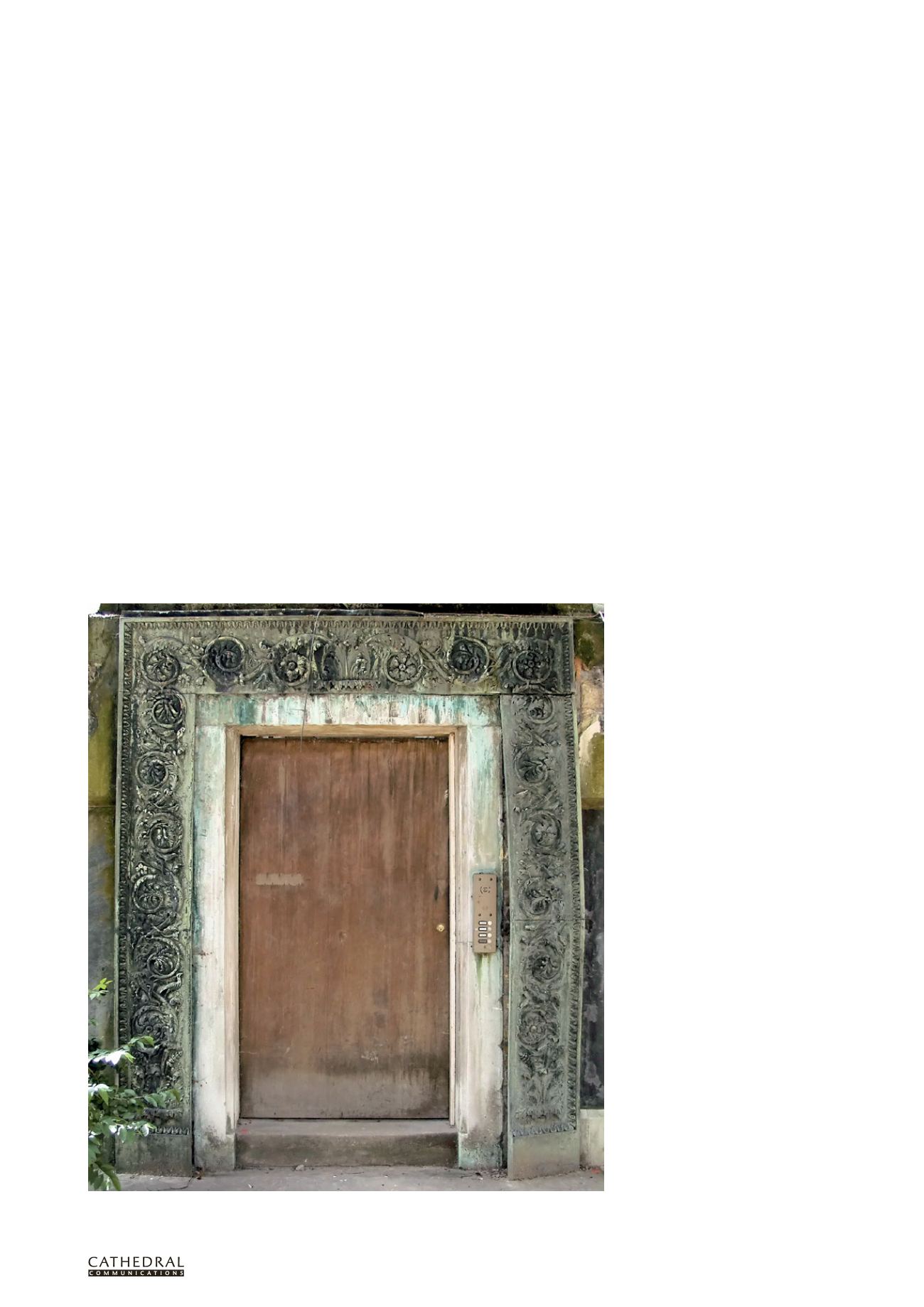
T W E N T Y F I R S T E D I T I O N
T H E B U I L D I N G C O N S E R VAT I O N D I R E C T O R Y 2 0 1 4
9 5
3.2
STRUCTURE & FABRIC :
MASONRY
marginal increases in tone until the words
lose their clarity. The aim is only to be over-
patinating where the lightened areas occur
rather than touching the undamaged patina.
REPAIRING PHYSICAL DAMAGE
‘Big Blue’, a Ron Arad statue at Canary
Wharf, London is a large fibreglass composite
sculpture with a spray painted surface finish
located at the centre of Canada Square.
Completed in 2000, this sculpture had
overzealous football supporters jump up and
down on its surface. The flexibility of the
domed surface and the rigidity of the paint
caused small areas of cracking which the
weather soon bombarded. Water seeping into
the fine cracks caused enlargement of the
damaged patches.
The conservation treatment involved
removing any flaking, blistering or loose
sections with hand tools, sanding back the
surface and allowing it to dry thoroughly. The
cavities were filled using glass fibre reinforced
repair paste, re-sanded and refilled. The
repairs were shaped to match the contours of
the sculpture, then the localised areas were
given several coats of polyurethane acrylic
primer, sanded off, and then given two coats
of prime-filler (applied before the coloured top
coat, prime-filler provides strong adhesion for
the top coat and fills any tiny scratches and pin
holes which have occurred during sanding).
These were sanded down with 240 and 400
grit abrasive paper. Three coats of metallic
base coat were used with fade-out thinner
to blend out the edges to create seamless
repaired areas. Three coats of clear urethane
coat lacquer were then applied, cutting back
between coats using 1000 grade wet and dry
abrasive paper. The entire surface was then
polished using machines and medium micro-
finishing compound. To remove scratches
and minor abrasions from the lacquered
surface, a white polishing pad was used
followed by a black polishing pad. Finally,
three coats of protective carnauba-based
wax were applied to achieve a high shine.
As noted above, unsuccessful metal theft
can still result in serious damage. This was the
case in the attempted theft of a beautiful cast
bronze ornamental frieze which surrounded
a doorway at the house of the famous 19th-
century artist Sir Lawrence Alma-Tadema.
The frieze was badly bent by the would-be
thieves, who eventually gave up. In another
incident which took place many years ago,
thieves who were attempting to steal a pair
of bronze statues called The Wrestlers of
Herculaneum dropped them onto the Victoria
Embankment during their getaway. One of the
statues was hit by a truck and in some places
the structure was squashed almost flat.
In both cases, realignment and reshaping
was achieved with the use of only modest
amounts of heat with very small bouts of
pressure to gradually pull the sculpture back
into shape. Patience and precision are vital
in this type of repair as a strong heat source
can significantly change the patina and if heat
and force are brought to bear simultaneously,
cracking will result.
Graffiti carved into a bronze statue,
particularly if it includes offensive words,
must be removed by a relatively intensive
process of cutting back the area using
various grades of diamond tipped pad or
abrasive paper. This is continued until
the word is obscured or begins to become
illegible. It is often unnecessary to remove
every remnant of it as surface scratches are
reasonably acceptable on a bronze and can
be made less obvious with patination.
Re-patination in such cases is very
difficult. Small areas are very hard to blend in
with the surroundings as there is very little
transitional area. Matching patina that is
mature and has developed its colour over a
century or more is extremely difficult. Burned
patinas, which are produced by heating the
bronze with a torch before applying patination
compounds, are not suitable in this context
because heating the original patina, which
cannot be avoided in a small space, can cause
damage. In extreme cases, heating can even
burn off the patina altogether. Cold patinas
with a sulphide base can be very useful in
these contexts. These chemical compounds
can be used to achieve a given colour on a
bronze without the application of heat but they
often have to be mixed on site and modified to
achieve a sufficiently close match. Preparing
a bespoke cold patina can avoid a new ‘freckle
effect’ in the middle of an aged patina. Final
tints are often necessary which involve
working with an earth pigment component
and wax to achieve a seamless finish.
CAUSE AND EFFECT
It is perhaps a little simplistic to look at
the motives behind vandalism only in
terms of the broad categories discussed
at the beginning of this article. In reality,
the motives overlap – social problems and
tagging, for example, often coincide. In
Banksy’s words ‘graffiti is one of the few
tools you have when you have nothing.’
However, it is useful for a conservator
to consider the why of vandalism or theft,
because knowing your vandal not only
helps with choosing the best conservation
treatments, but also makes it easier to help
prevent the damage occurring again. When
you put a label on the type of vandalism that
has occurred then the preventive conservation
solutions often become obvious. Then the
conservator can work with the client to ensure
that the damage goes away and stays away.
LUCY BRANCH
MA ACR is a director of
Antique Bronze Ltd
After
undergraduate studies in Art History
and Materials, she entered her family’s
conservation business. She undertook a mid-
career master’s in conservation and continues
to work on well-known monuments such as
Nelson’s Column and the Albert Memorial.
Cast bronze ornamental frieze which was bent during a failed attempt to steal it


